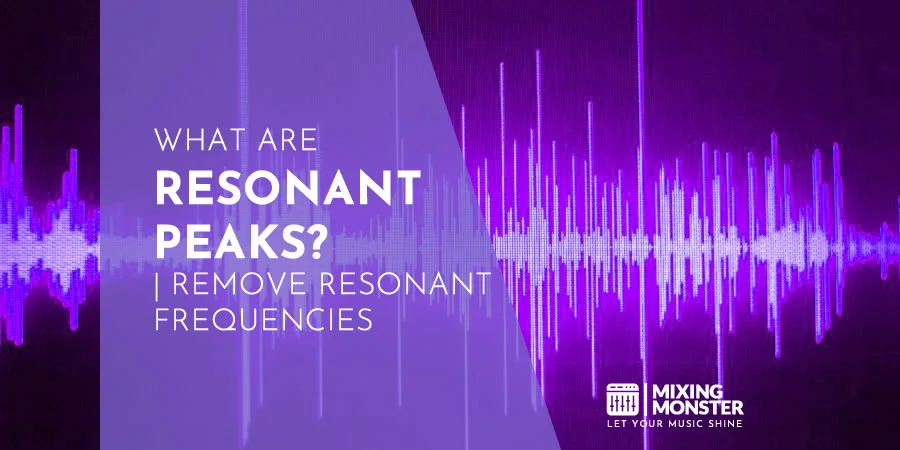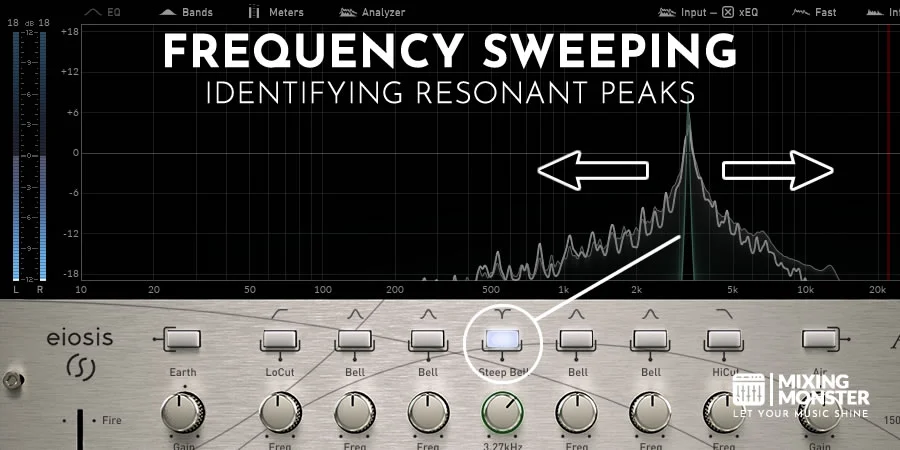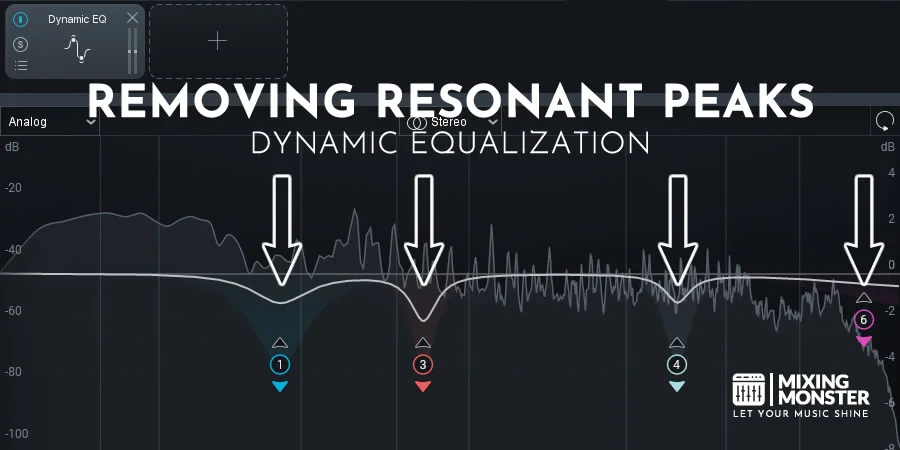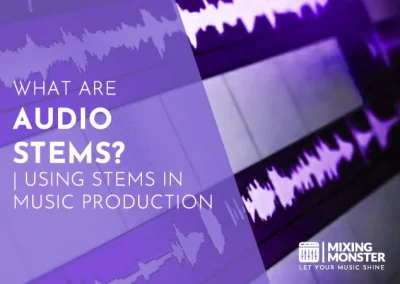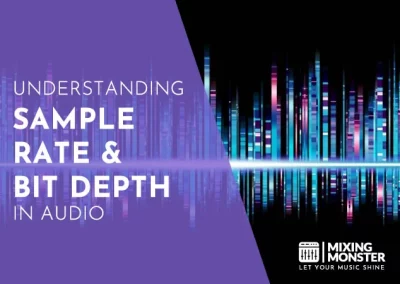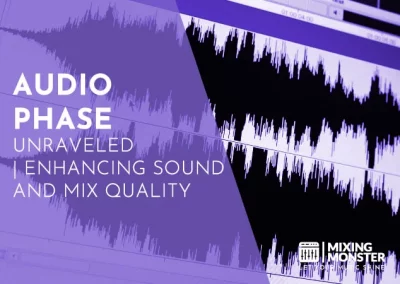Home > Blog > Mixing > Mixing Insights
Resonant peaks are a fundamental aspect of sound engineering and audio processing. Understanding how to manage and control them can make a significant difference in the quality of sound recordings and performances.
Resonant peaks are frequency spikes in audio signals that occur when sound waves resonate within an environment or device. These peaks can cause certain frequencies to become more prominent than others, affecting the audio volume and quality. In audio processing, resonant peaks can be both desirable and undesirable, depending on the specific application.
Understanding how to identify and work with resonant peaks is crucial for anyone involved in sound engineering, as they can significantly impact the perceived quality of sound recordings.
Table Of Contents
1.What Are Resonant Peaks In Audio Processing?
2. The Different Types Of Resonances In Analog And Digital Audio
3. Impacts Of Resonant Peaks On Audio Quality
4. Resonant Peaks: Frequency Response And Equalization
5. How To Identify Resonant Peaks In Audio Processing
6. How To Remove Resonant Peaks In Audio Processing
7. Benefits Of Removing Resonant Peaks In Audio Processing
8. Conclusion

1. What Are Resonant Peaks In Audio Processing?
Have you ever listened to a recording and noticed a harsh, unpleasant sound at a certain frequency? This could be due to resonant peaks or resonant frequencies, which are important aspects in audio processing.
Resonant peaks are specific frequencies in a sound wave that are amplified due to the resonant properties of the objects in the environment, your playback system or frequency interactions in your audio mix.
For example, resonant peaks occur when sound waves bounce back and forth between surfaces, resulting in an amplification of certain frequencies. Resonant frequencies, on the other hand, refer to the natural frequency of an object, which can also create resonant peaks in sound recordings.
In audio processing, resonant peaks are crucial because they can significantly impact the perceived quality of sound recordings. Resonant peaks can cause certain frequencies to sound overly loud or harsh, resulting in a less pleasant listening experience.
To address resonant peaks in audio processing, techniques such as filtering, equalization, or compression can be used. These techniques adjust the resonance of a sound, either by reducing the volume of the resonant peak or by boosting other frequencies to balance out the sound.
Resonant peaks are important to identify and in audio processing because they can affect the quality of a recording. By understanding and adjusting resonant peaks, sound engineers can create a more balanced and pleasant listening experience.
2. The Different Types Of Resonances In Analog And Digital Audio
The difference between resonances in digital audio and analog audio lies in the way that the signal is processed and represented.
In analog audio, resonances occur due to the physical properties of the sound waves and the analog equipment used to capture and process them. Resonances can be caused by the acoustic properties of a room, the resonance of a microphone or speaker, or the natural resonance of an instrument.
Analog resonances are typically caused by physical components and can be difficult to eliminate completely, but they can also add warmth and character to the sound.
Types Of Resonances That Can Occur In Analog Audio:
- Room Resonances:
These are caused by the shape and size of a room and the materials used in its construction. When sound waves bounce off walls, floors, and ceilings, they can create resonant peaks at certain frequencies, resulting in a less balanced or unpleasant sound. - Speaker Resonances:
These are caused by the properties of the speaker itself, such as the size, shape, and materials used. Speaker resonances can result in certain frequencies being amplified or muffled, leading to a less accurate representation of the original sound. - Microphone Resonances:
Audio resonances in microphones are caused by the physical properties of the microphone’s diaphragm and housing. Resonances can occur at certain frequencies when sound waves cause the diaphragm to vibrate, which can result in a boost or dip in the frequency response of the microphone. - Instrument Resonances:
These are caused by the physical properties of musical instruments, such as the size and shape of a guitar body or the material of a drumhead. Instrument resonances can give an instrument its unique sound but can also create resonant peaks that need to be addressed in audio processing. - Ear Resonances:
These are caused by the natural resonant properties of the human ear, which can amplify or attenuate certain frequencies. Ear resonances can affect the way we perceive sound and need to be considered when creating and processing audio.
In digital audio, resonances are caused by the limitations of the digital representation of sound. Sampling rate resonances can occur if the digital sampling rate is not high enough, and filter resonances can occur if digital filters are not implemented correctly. Phase resonances can also occur due to the way digital signals are processed.
Digital resonances are typically caused by mathematical algorithms and can be more precise and easier to eliminate than analog resonances.
Types Of Resonances That Can Occur In Digital Audio:
- Sampling Rate Resonances:
These are caused by the digital sampling process used to convert analog sound into a digital signal. If the sampling rate is not high enough, it can create resonant peaks or “aliasing” at certain frequencies, resulting in distortion or a less accurate representation of the original sound. - Filter Resonances:
These can occur when digital filters are used to adjust the frequency response of a sound. Filters can introduce resonant peaks at certain frequencies, leading to a less balanced or unpleasant sound. - Phase Resonances:
These are caused by the way in which digital audio signals are processed, which can result in phase shifts that create resonant peaks or dips in the frequency response. - Plugin Resonances:
These can occur when using digital audio processing plugins or effects, which can introduce resonant peaks or other artifacts in the audio signal.
To wrap things up, analog resonances are caused by physical components, while digital resonances are caused by the limitations of the digital representation of sound. Both types of resonances can be addressed through careful audio processing techniques to create a balanced and accurate sound.

3. Impacts Of Resonant Peaks On Audio Quality
Resonant peaks can have a significant impact on the quality of audio recordings, leading to a less accurate or unpleasant sound.
Resonant peaks can create boosts or dips in the frequency response of a recording, causing frequency imbalances while leading to an unbalanced or unnatural sound. This can make it more difficult to distinguish individual instruments or sounds in a mix.
They can cause distortion or clipping in a recording, particularly if the peaks are too high or occur at the same frequencies as other sounds in the mix.
Other than that, resonant peaks can mask or obscure other sounds in the mix, particularly if they occur at similar frequencies to other sounds. This can make it more difficult to hear individual instruments or sounds in a recording.
Last but not least, resonant peaks can create unpleasant or harsh artifacts in a recording, particularly if they are not controlled or minimized. This can result in a less enjoyable listening experience for the listener or even “destroyed” audio.
The impacts of resonant peaks on audio quality can be found in a variety of recording contexts:
For instance, a poorly positioned microphone in a room with poor acoustics can create resonant peaks that make the recording sound boomy or unnatural.
A poorly tuned sound system can also create resonant peaks that make the music sound harsh or distorted.
Resonant peaks can also be introduced during the mixing or mastering process, particularly if filters or equalization are not used carefully to control them.
By understanding the impacts of resonant peaks on audio quality, sound engineers can take steps to minimize them and create high-quality recordings that accurately represent the original sound.

4. Resonant Peaks: Frequency Response And Equalization
Frequency response is the measure of how well a device reproduces a range of frequencies.
In that context, resonant peaks are spikes in the frequency response of a device caused by resonances in the device’s construction or design itself. They can cause certain frequencies to be emphasized or reduced, leading to an uneven or colored frequency response.
Equalization (EQ) can be used to adjust the resonance of a sound by selectively boosting or cutting certain frequencies. A parametric EQ, for example, allows the user to select a specific frequency range and adjust its amplitude.
By reducing the amplitude of a resonant peak, EQ can help to create a more balanced and natural frequency response. Conversely, by boosting a certain frequency range, EQ can enhance a sound’s character or emphasize certain elements of a mix.
The frequency response of a physical device can be controlled by applying equalization to it (pre or post equalization) in order to ensure an accurate representation of the sound.
However, it’s important to note that overuse or misuse of EQ can lead to a less natural or less accurate sound.
In some cases, it may be better to address resonant peaks through other means, such as by changing the positioning of microphones, adjusting the acoustics of a room, or using different equipment.

5. How To Identify Resonant Peaks In Audio Processing
Before you can address resonant peaks or frequencies in a mix, you obviously need to to identify them. Even though this is a common and very important task in audio engineering, it can become a nightmare, especially in huge audio projects.
Identifying resonant frequencies in audio processing involves identifying peaks or dips in the frequency response of a signal.
How To Identify Resonant Peaks In Audio Processing:
- Use An Equalizer:
Use an equalizer to “sweep” through the frequency range of the signal, increasing or decreasing the gain of each frequency band until you hear a peak or dip in the response. A parametric equalizer with a narrow Q value can help you identify more precise frequency ranges. - Use A Spectrum Analyzer:
A spectrum analyzer can display the frequency response of a signal as a graph, making it easier to identify peaks and dips in the response. Look for spikes or valleys in the graph to identify resonant frequencies. Some equalizer plugins already include a spectrum analyzer. - Use A Frequency Generator:
Use a frequency generator to generate a sine wave at a particular frequency, and listen for any resonant frequencies in the response. Move the frequency up and down until you find the resonant frequency. - Use Your Ears:
Simply listen to the audio signal and pay attention to any areas that sound unusually harsh, loud or quiet. These could be indications of resonant frequencies.
Again, it’s important to note that identifying resonant frequencies is just the first step in addressing them. Once you’ve identified a resonant frequency, you’ll need to decide whether to adjust it using EQ or other processing techniques, or to address it through other means such as changing the placement of microphones or improving the acoustics of the recording space.
6. How To Remove Resonant Peaks In Audio Processing
Removing resonant peaks can help to improve the quality and clarity of audio recordings, making them more enjoyable to listen to and easier to work with in post-production. There are several audio processing techniques that can be used to remove resonant peaks in audio.
Common Techniques To Remove Resonant Peaks In Audio:
- Equalization:
One of the most common ways to remove resonant peaks is by using an equalizer to reduce the gain of the frequency band causing the resonance. A parametric EQ with a narrow Q value can be especially useful for this purpose, as it allows you to pinpoint the exact frequency range of the resonance. - Notch Filters:
A notch filter is a type of EQ that specifically targets a narrow frequency band and reduces its gain. Notch filters are especially useful for removing resonant peaks that are relatively narrow in frequency range. - Dynamic Processing:
In some cases, a resonant peak may only occur at certain points in a recording, such as when a singer hits a particular note. Dynamic processing techniques such as multiband compression or dynamic EQ can be used to reduce the gain of resonant peaks only when they occur, while leaving the rest of the audio untouched. - De-Essing:
De-essing is a type of dynamic processing that specifically targets sibilant sounds in vocal recordings, which can often be the result of resonant peaks. De-essers use frequency-specific compression to reduce the gain of sibilant sounds without affecting the rest of the audio. - Re-Recording Or Remixing:
In some cases, the best way to remove a resonant peak may be to simply re-record or remix the audio. For example, if a resonant peak is caused by a particular microphone placement or recording environment, adjusting the microphone placement or using a different recording space may be the best solution.
It’s worth noting that removing resonant peaks can be a delicate process, as overuse or misuse of processing techniques can result in an unnatural or unpleasant-sounding recording.
In many cases, it may be better to address resonant peaks through other means and take a “step back” such as changing the placement of microphones or improving the acoustics of the recording space, rather than relying too heavily on processing techniques.

7. Benefits Of Removing Resonant Peaks In Audio Processing
As already mentioned, balancing out or removing resonant peaks in audio can have a significant impact on the overall quality of the sound and there are several benefits of addressing them in a mix.
Resonant peaks can cause certain frequencies to be overly pronounced or muddied, which can make it difficult to hear other parts of the audio clearly. Removing these peaks can help to balance the frequency response and improve the overall clarity of the sound.
Resonant peaks can also cause the audio to sound unnatural or artificial. By removing these peaks, the audio can sound more natural and true-to-life.
In addition to that, resonant peaks can also limit the dynamic range of the audio, making it sound compressed or flat. Removing these peaks can help to restore the dynamic range, allowing the audio to sound more lively and dynamic.
Removing resonant peaks can make it easier to mix and master the audio, as the frequency response will be more balanced and consistent. This can result in a more polished and professional-sounding final product.
Overall, removing resonant peaks can help to improve the quality and clarity of audio recordings, making them more enjoyable to listen to and easier to work with in many audio engineering scenarios.
7. Conclusion
In conclusion, resonant peaks are a common occurrence in audio processing, particularly in digital audio where they can have a significant impact on the overall quality of a sound.
Identifying and addressing resonant peaks can be a delicate process, but with the right techniques, tools, and knowledge, it is possible to reduce or remove them, resulting in improved clarity, a more natural sound, better dynamic range, and easier mixing and mastering.
Whether you are a music producer, sound engineer, or just a casual listener, understanding resonant peaks and how to address them can help you to create and enjoy high-quality audio recordings.


